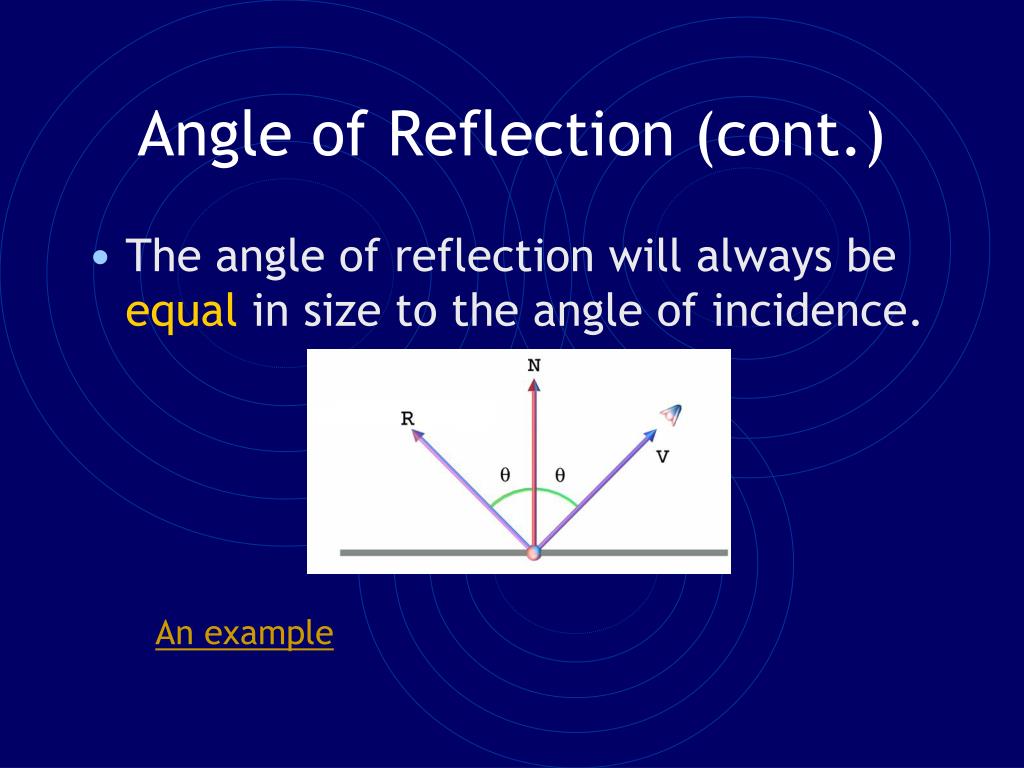

The initial topics that are introduced through their lessons are laws of reflection and refraction of light. An example of an angle of incidence is the angle between a light hitting a table and a line perpendicular to the table. Students are often introduced to optics in their middle school years. The definition of an angle of incidence is an angle made by a light ray or wave hitting a surface and the line perpendicular to that surface. What is an example of angle of incidence? The Angle of Incidence Equals the Angle of Reflection View Large On Black Every now and then one gets a chance to capture the perfect reflection, thanks mother nature This was taken on the Cache la Poudre River under the amazing Bellvue Dome. According to the law of reflection, the angle of incidence equals the angle of reflection. If a line is drawn perpendicular to that point, it is called the normal. The point at which the light hits the surface is called the point of incidence. Or in less technical language, the angle at which light hits a surface (angle of incidence) is equal to the angle at which light bounces away from the surface (angle of reflection). According to Snells Law of reflection, the angle of incidence equals the angle of reflection, and for transmissive media the refracted (transmitted) beams. The ray that gets reflected away is called the reflected ray. The angle of incidence is the angle between this normal and the incident ray the angle of reflection is the angle between this normal and the reflected ray. The law of reflection says that the angle of incidence is equal to the angle of reflection. We can find the angle of incidence by using Snell's Law. What is the formula of angle of incidence? Simply why angle of incidence is equal to angle of reflection Ray Optics is based on Fermat Principle. Now, we have got the complete detailed explanation and answer for everyone, who is interested! Angle between incident ray and reflecting surface normal is equal to angle between reflected ray and reflecting surface normal. Hence the correct answer will be angle of reflection.This is a question our experts keep getting from time to time. The angle between the incident ray and the normal line is.

SECOND LAW- It states that that the angle of incidence is equal to the angle of reflection irrespective of the type of reflection.i.e i =r A line that is perpendicular ( 90o with the surface) to the plane mirror is called the normal line. There are two types of reflection.One is called regular and other one is called as irregular.The laws of reflection is valid for both the types of reflection.įIRST LAW -It states that the incident ray,reflected ray and the normal to the point of incidence,all lie in one plane. The law of reflection states that the principle when the light rays fall on the smooth surface, the angle of reflection is equal to the angle of incidence, also the incident ray, the reflected ray, and the normal to the surface all lie in the same plane. The angle made by the reflected ray with the normal is called angle of incidence.Let it be denoted as Let us consider a normal to the point of incidence.The angle made by incident ray with the normal is called angle of incidence.Let it be denoted as The ray which falls on the reflecting surface is called incident ray and the ray which is reflected is called reflected ray. Direction of light is perpendicular to the direction of wavefront, hence it all depends on how wavefront changes. Whenever a light ray will incident on a mirror or any reflecting surface, it will be reflected. In the case of reflection, when we apply this principle and trace the reflected wavefront it is seen that the angle of incidence is equal to the angle of reflection (geometrical proof).

Angle of Incidence Angle of Reflection The Law of Reflection. Reflection is the optical phenomenon in which light will bounce back to the same medium from which it had originated. Waves bounce off a surface at the same angle they strike it: reflection: incident ray and. Before going to answer this question first we have to understand reflection and laws of reflection.


 0 kommentar(er)
0 kommentar(er)
